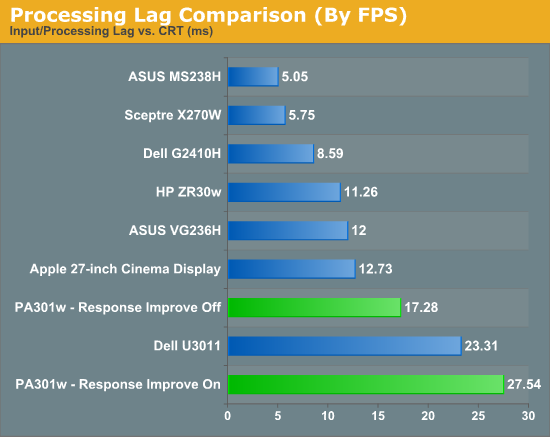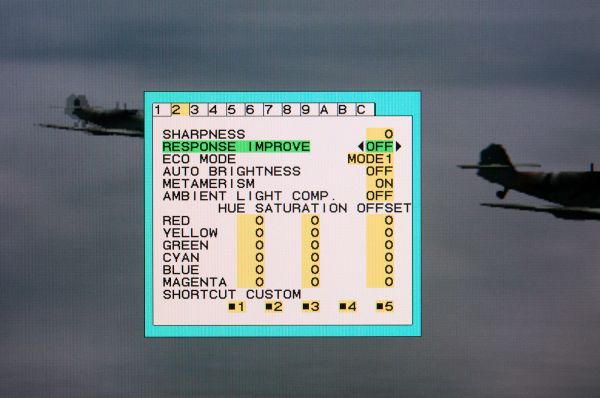NEC PA301w: The Baddest 30-inch Display Around
by Brian Klug on March 1, 2011 8:00 AM ESTInput and Processing Latency
So I was super late on getting the input latency section done, my sincere apologies if you've been refreshing endlessly every day as one day turned into an additional three. The delay was no fault of the PA301w, it was entirely just the sheer amount of stuff being worked on behind the scenes during just another busy week at AnandTech. Enough with my excuses though, let's get on to the results.
Processing and input lag are both serious considerations for gamers, but also noticeable after a certain point doing even the most mundane of desktop productivity tasks. It's that nagging - something feels off - sensation that really drains on one after a while. We've been doing our best to characterize input latency so far by doing some real world tests alongside CRTs. First with a 17" Princeton, then a Sony G520 20" CRT. The results so far have actually shown a fair amount of variance in input latency.
I measured latency on the PA301w the same way we've done it in the past. I run the 3DMark06 wings of fury demo on loop, and take photos of the display in test alongside a mirrored CRT at shutter speeds at or faster than 1/160th of a second. Resolution is set at XGA so we can crank the refresh all the way up on both displays (on the PA301w that's 75 Hz at XGA, 60 Hz at native). I snap a bunch of photos, and average a ton that show the difference in frame number between the two, and through some math we can get a decently accurate feel for what input latency is like.
You won't find it in the normal OSD, but in the Advanced OSD the PA301w has an interesting option labeled "Response Improve," which I can only assume is essentially overdrive control. I tested with this set to on and off, and found something interesting:

Remember that I'm driving both the CRT and PA301w at 75 Hz. At that refresh rate, one frame is 13.33 ms, two frames is 26.66 ms. Given how close those numbers are to the measured times, it looks like turning response improve on adds one more frame of latency. Interestingly enough, the difference between response improve turned on and off is actually visually noticeable. With response improve on, the numbers I read out of super fast shutter images of the PA301w are crisp and readable. With response improve off, almost 50% were lost to two frames being present and making it hard to discern the numbers. This is again the tradeoff you make - better panel response and less ghosting through overdrive, but at the cost of some additional processing latency if you look at it with a camera. I spent some time playing the Crysis 2 multiplayer demo and couldn't detect any latency subjectively with the setting on or off - you're a better gamer than I if you can pick that 10 ms difference out in actual practice.
Custom Refresh Rates
Ganesh (our resident HTPC expert) has also been asking me to add some custom refresh rate testing to our display review suite. Refresh rates like 23.976, 24, 25, 29.97, 50, and 59.94 Hz. I entered the custom refresh rates into the NVIDIA Control Panel and tested them on my GTX 470. All of the above refresh rates were supported at 1920x1080, which is the most likely place to encounter a bunch of those. The OSD appears to round appropriately for all refresh rates but 59.94, which it displays as 59.9 Hz. Curiously enough 23.976 Hz displays as 24 Hz, but displays just fine.

















92 Comments
View All Comments
Shadowmaster625 - Tuesday, March 1, 2011 - link
Imagine gaming with 3 of these. wowee wowee wowee.Now imagine having to work for weeks on end to be able to pay for them. lol
ImSpartacus - Tuesday, March 1, 2011 - link
I'm definitely not educated on the subject, but wouldn't the response time be detrimental to most gaming?But from a purely size and resolution standpoint, it would be pretty neat.
DanNeely - Tuesday, March 1, 2011 - link
If it's the same 2 frames as the 3090 had it's only really going to be an issue in FPSes at higher skill levels and on a low latency connection. For anything else it's fine.softdrinkviking - Tuesday, March 1, 2011 - link
I have the 24" version of this. (it's available where I live) and it's fine for gaming. There is some acceleration hardware inside that seems to work well. It's fine for sports or movies to me.Perhaps you are more sensitive than I, but I think it looks fantastic.
Interesting note though. The contrast ratio on the NEC PA series monitors that I've seen is 800:1, whereas the other series they make, the LCD2409, 2609, ect, are H-IPS, and list a higher contrast ratio of 1000:1.
I noticed this when shopping, printed on all the little spec cards at the store.
I wonder if this is a trade-off for the better color depth of the S-IPS panels?
I understand that the contrast numbers given can vary in actual meaning, but I'm assuming NEC uses the same criteria for contrast across its professional line.
Stas - Wednesday, March 2, 2011 - link
Because size matters...thereaderrabbit - Tuesday, March 1, 2011 - link
The kilowatt is equal to one thousand (10^3) watts. I think this is what you mean by Kill-A-Watt.LukeDK - Tuesday, March 1, 2011 - link
A Kill-A-Watt is a device used for measuring power consumption (or voltage, current, frequency, etc) at the plug.LTG - Tuesday, March 1, 2011 - link
So nice to see someone point out a correction without insult or condescencion.MobiusStrip - Tuesday, March 1, 2011 - link
He must be new to the Internet.Stas - Wednesday, March 2, 2011 - link
What a wuss